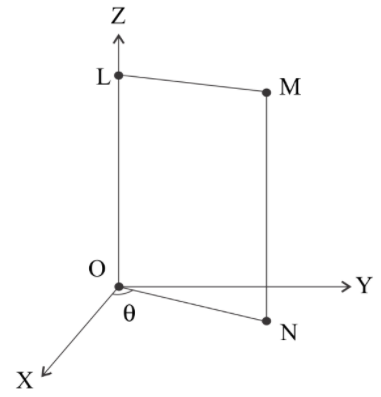
The electric field intensity at all points in space is given by

A) 0 volt meter
B) 1 volt meter
C) 2 volt meter
D) 4 volt meter
Answer
142.8k+ views
Hint: The magnitude of the electric flux through the square frame is the dot product of the electric field intensity with the area of the frame.
Complete step by step solution:
The electric field intensity is given to us. The electric field intensity does not vary with position or time, thus it is a constant vector. The area of the square frame is 1
Now, we can find out the electric flux passing through the area enclosed by the square frame by taking the dot product of electric field intensity and area vector. On taking dot product, we obtain,
We now substitute the values of the vectors of area and electric field intensity in equation (1). We get,
Hence, the electric flux passing through the square frame is 2 volt meter.
Therefore, the correct answer of the question is option (C).
Note: The above question can also be solved by finding out the magnitude of the electric field intensity vector and area vector and then finding out the angle between these vectors to find out the electric flux passing through the square frame. But, doing that is more prone to errors because it will be relatively more calculation intensive.
Complete step by step solution:
The electric field intensity is given to us. The electric field intensity does not vary with position or time, thus it is a constant vector. The area of the square frame is 1
Now, we can find out the electric flux passing through the area enclosed by the square frame by taking the dot product of electric field intensity and area vector. On taking dot product, we obtain,
We now substitute the values of the vectors of area and electric field intensity in equation (1). We get,
Hence, the electric flux passing through the square frame is 2 volt meter.
Therefore, the correct answer of the question is option (C).
Note: The above question can also be solved by finding out the magnitude of the electric field intensity vector and area vector and then finding out the angle between these vectors to find out the electric flux passing through the square frame. But, doing that is more prone to errors because it will be relatively more calculation intensive.
Latest Vedantu courses for you
Grade 10 | MAHARASHTRABOARD | SCHOOL | English
Vedantu 10 Maharashtra Pro Lite (2025-26)
School Full course for MAHARASHTRABOARD students
₹33,300 per year
EMI starts from ₹2,775 per month
Recently Updated Pages
How to find Oxidation Number - Important Concepts for JEE

How Electromagnetic Waves are Formed - Important Concepts for JEE

Electrical Resistance - Important Concepts and Tips for JEE

Average Atomic Mass - Important Concepts and Tips for JEE

Chemical Equation - Important Concepts and Tips for JEE

Concept of CP and CV of Gas - Important Concepts and Tips for JEE

Trending doubts
JEE Main 2025 Session 2: Application Form (Out), Exam Dates (Released), Eligibility, & More

JEE Main Exam Marking Scheme: Detailed Breakdown of Marks and Negative Marking

JEE Main 2025: Derivation of Equation of Trajectory in Physics

Electric Field Due to Uniformly Charged Ring for JEE Main 2025 - Formula and Derivation

Electric field due to uniformly charged sphere class 12 physics JEE_Main

Degree of Dissociation and Its Formula With Solved Example for JEE

Other Pages
JEE Advanced Marks vs Ranks 2025: Understanding Category-wise Qualifying Marks and Previous Year Cut-offs

JEE Advanced 2025: Dates, Registration, Syllabus, Eligibility Criteria and More

JEE Advanced Weightage 2025 Chapter-Wise for Physics, Maths and Chemistry

Physics Average Value and RMS Value JEE Main 2025

Dual Nature of Radiation and Matter Class 12 Notes: CBSE Physics Chapter 11

Formula for number of images formed by two plane mirrors class 12 physics JEE_Main




